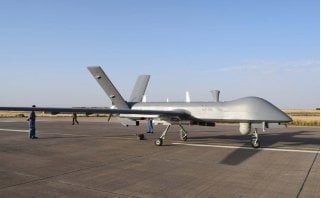Since November 2020, a complex and tragic civil war has raged in the Tigray region of Ethiopia pitting Tigrayans, led by Ethiopia’s former ruling elite, against Ethiopia’s federal government and the Eritrean military, which has intervened in support of Addis Ababa. Fighting has already killed thousands of combatants and civilians and displaced over 1.7 million people.

Amidst reports of atrocities, indiscriminate airstrikes, regional spillover, and dramatic battlefield reversals, the escalating conflict was marked in its early days by long-distance attacks by advanced missile and artillery systems imported from China. Furthermore, there have been persistent claims of the use of armed drones which remained unverified until this summer.
While such weapons may be at the forefront of the arms race between China, Russia, and the United States, the Tigray conflict illustrates how affordable variants of these weapons are making their way into conflicts involving less wealthy actors too.
The Peace Prize that Led to War
Ethiopia is a multi-national federal republic, with Oromo and Amhara ethnicities accounting for over half of the population. But between 1991 and 2018, Ethiopia was mostly ruled in an authoritarian fashion by ethnic Tigrayans, who constitute around six percent of the population, in the Tigray People’s Liberation Front (TPLF) party. Many of these Tigrayans also nursed a deep grudge against Eritrea, which seceded from Ethiopia in 1991.
In 2018, a multi-ethnic coalition finally defeated the TPLF electorally, bringing Prime Minister Abiy Ahmed to power. He proceeded to end hostilities with Eritrea for which he received the Nobel Peace Prize.
This promising development, unfortunately, heralded the war to come, as it infuriated TPLF which Abiy increasingly sought to repress. When Abiy canceled parliamentary elections in September 2020 allegedly due to the coronavirus threat, the TPLF held a regional vote anyway. As Abiy sought to assert control over the defiant region, on November 3 Tigrayans attacked army bases in Tigray, looting many heavy weapon systems.
In response, Abiy deployed the military to crush the rebellion, assisted by aerial bombardments, Amhara militias, and even the Eritrean military. Ethiopian forces captured the Tigrayan capital of Mekelle by the end of November.
But in the following months, mounting atrocities (massacres, ethnic cleansing, systematic mass rapes) especially by Amharan militias and Eritrean troops and indiscriminate air strikes caused recruitment and defections to the Tigrayan rebels to surge.
Finally, in a stunning reversal, in June 2021 the Tigray Defense Forces (TDF) counterattacked, recapturing Mekelle and compelling federal troops to withdraw from Tigray. Today a two-front war rages, with the TDF still fighting Eritrean troops to the north while its forces advance southward down the B30 highway towards Gondar in the Amhara region.
Source: The National Interest


